MaryAnn Bernal's Blog, page 262
July 6, 2014
Interview with Rex Baughman whose life events inspired the novel, Ty the Bull

Brenda:Hi Rex. Please tell us a little about you.
Rex:
Well, I really like to be active unless there is no one I like to play with. Then I will stay inside. I like to stay positive. Some kids will get bored or sad right away but I like to look at the bright side of things.
Brenda:That is so good Rex. I love hearing that. A positive outlook is a great thing.
If you were to write another book what would you write about Rex?
Rex:I would want to write about a motorcycle cop and a girl in a bikini with a bunch of zaliens and gorons.
Brenda:What in the world is a zalien and a goron?
Rex:
Those are my made up characters. They are zombie aliens. They are kind of like aliens and gluten free maniacs.
Brenda:Haha... What do you know about gluten free?
Rex:I know some people eat brownies without gluten.
Brenda:I'm learning something new everyday!
What have you been bullied about?
Rex: Being fat even though I know I am not fat. They say that because I am bigger than them. They call me the basic names like idiot. Mostly they just call me fat.
Brenda:Oh gosh Rex. I hope you don’t believe what they say.
Rex:
I don’t but they say stuff like that.
Brenda:What do you want your readers to take away from your book.
Rex:I want them to know that when they are bullied they are not alone. They are not the only one’s they have this happen to. Since it is more talked about it is not such a big surprise.
Brenda:So again, you are saying that they are not alone.
Rex:That’s right.
Brenda:On that note, what are your parting words?
Rex: A lot of the other kids are being bullied, you can relate to the other kids if you are being bullied too.
Brenda:Anything else?
Rex:STAY COOL

Ty the Bull, on sale now http://www.amazon.com/dp/B00LK572S2/ref=cm_sw_su_dp

Published on July 06, 2014 04:14
History Trivia - Richard III crowned King of England
July 6

Henry II1189 King Henry II of England died and was succeeded by his son, Richard I, the Lionheart.

1348 Pope Clement VI issued a Papal bull protecting the Jews accused of having caused the Black Death.
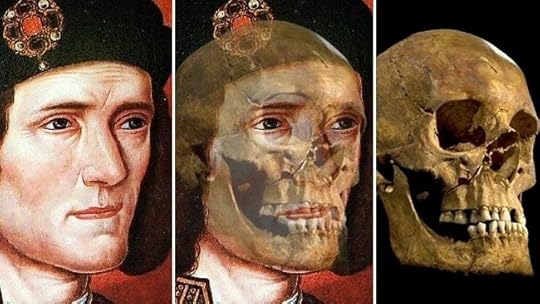
1483 Richard III was crowned King of England.

1535 Sir Thomas More was executed for refusing to accept Henry VIII as head of the Church of England.

1560 The Treaty of Edinburgh was signed by Scotland and England.

1553 Edward VI Tudor, King of England (1547-53), died at age 15.


Henry II1189 King Henry II of England died and was succeeded by his son, Richard I, the Lionheart.

1348 Pope Clement VI issued a Papal bull protecting the Jews accused of having caused the Black Death.

1483 Richard III was crowned King of England.

1535 Sir Thomas More was executed for refusing to accept Henry VIII as head of the Church of England.

1560 The Treaty of Edinburgh was signed by Scotland and England.

1553 Edward VI Tudor, King of England (1547-53), died at age 15.

Published on July 06, 2014 04:09
July 5, 2014
Fossils of dinosaur-era forest fire discovered in Canada
 A fossil of a leaf from the Salix genus, which includes willows, found during the study of 66-million-year-old plants in Saskatchewan.Larsson/Bamforth In the badlands of southern Saskatchewan, Canada, scientists discovered evidence of a 66-million-year-old forest fire locked in stone.
A fossil of a leaf from the Salix genus, which includes willows, found during the study of 66-million-year-old plants in Saskatchewan.Larsson/Bamforth In the badlands of southern Saskatchewan, Canada, scientists discovered evidence of a 66-million-year-old forest fire locked in stone.Fossilized plants found on top of the layers of ancient charcoal show that forests bounced back from wildfires during the last days of the dinosaurs much like they do today, the new study found.
Dry, treeless grasslands cover much of southern Saskatchewan today, but 66 million years ago, the region was covered in swampy, lowland forests. It was perhaps six times rainier and 18-26 degrees Fahrenheit warmer than it is today, the researchers said. The area may have resembled North America's Pacific Coast, with forest canopies dominated by towering sequoias and a diversity of smaller plants growing closer to the ground. [See Photos of Fossils from the Ancient Forest]
The ancient forests also suffered the occasional fire. Researchers from McGill University, in Montreal, and the Saskatchewan Museum found evidence of one of those blazes among fossilized plants at Grasslands National Park, in a geologic layer known as the Frenchman Formation (so named because it's exposed around the Frenchman River).
This rock deposit is a natural time capsule from the Late Cretaceous Period, just before a mass extinction wiped out the dinosaurs. In this layer of stone and dirt, scientists have discovered the fossils of ancient turtles, crocodiles, croc-like champsosauruses, as well as dinosaurs, including Tyrannosaurus rex and the three-horned Triceratops horridus.
The scientists compared the fossils at Grasslands to another deposit without any fire disturbance, located about 125 miles away in a valley called Chambery Coulee. Differences in the type of plants found at both sites reveal how the prehistoric landscape recovered after a fire.
Similar to patterns of regrowth seen today, the fossils from Grasslands showed that plants like alder, birch and sassafras started popping up in the early stages after the fire. Meanwhile, the fossils from Chambery Coulee told the scientists that sequoia and ginkgo would have been thriving in mature forests that hadn't been scorched by a blaze.
The researchers hope their findings and further study will help them understand the forest ecology and biodiversity in this region immediately before the dinosaurs fell.
"We won't be able to fully understand the extinction dynamics until we understand what normal ecological processes were going on in the background," study researcher Hans Larsson, of McGill University, said in a statement.
http://www.foxnews.com/science/2014/06/06/fossils-dinosaur-era-forest-fire-discovered-in-canada/

Published on July 05, 2014 16:14
How Evolving Traits Helped Humans Survive Unstable World
By Charles Q. Choi,
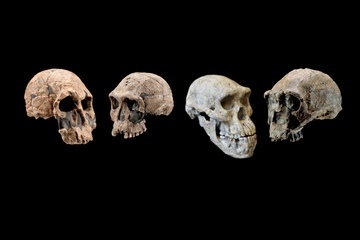
 Three early human species likely co-existed at the dawn of humanity between 2.1 million and 1.8 million years ago, including the 1470 group (likely Homo rudolfensis) and the 1813 group, likely Homo habilis, (left and second from left, respectively). The other fossils represent Homo erectus, which evolved by 1.8 million to 1.9 million years ago.
Three early human species likely co-existed at the dawn of humanity between 2.1 million and 1.8 million years ago, including the 1470 group (likely Homo rudolfensis) and the 1813 group, likely Homo habilis, (left and second from left, respectively). The other fossils represent Homo erectus, which evolved by 1.8 million to 1.9 million years ago.Credit: Chip Clark, Smithsonian Human Origins Program (left three); Guram Bumbiashvili, Ge orgian National Museum (right)
Three different human species may have walked the Earth at the dawn of the human lineage, dividing up their environment in slightly different ways, and the ancestors of modern humans may have survived because oftraits such as large brains that helped them adapt to unstable, shifting landscapes, researchers say.
Moreover, the defining features of the human lineage may not have evolved together gradually at once, but piecemeal in stages over millions of years, scientists added.
Modern humans, Homo sapiens , are the only living members of the human lineage, the genus Homo, which is thought to have arisen in Africa more than 2 million years ago. Many now-extinct human species were thought to once roam the planet, such as Homo erectus, the first to regularly keep the tools it made
Many traits unique to the human lineage were long thought to have originated between 2.4 million and 1.8 million years ago in Africa. These include a large brain and body, long legs, reduced differences between the sexes, increased meat-eating, prolonged maturation periods, increased social cooperation and tool making.
However, recent fossil evidence suggests these traits did not arise together as a single package. Instead, key human features evolved piecemeal at separate times, with some emerging substantially earlier and some later than previously thought. For instance, recent findings suggest long legs, a feature once considered unique to humans, developed in earlier ancestors, the genus Australopithecus, between 3 million and 4 million years ago, and stone tools about 2.6 million years old may predate the origin of Homo.
A dynamic birthplace
Scientists have long suggested that human evolution was linked to the onset of global cooling and the spread of a stable or progressively arid savanna grasslands in Africa. However, recent studies hint that early Homo may have evolved in a far more diverse environment, with the birthplace of humanity dominated from 2.5 million to 1.5 million years ago by an unstable climate, shifting intensity of annual wet and dry seasons, and varied landscapes.
This changeable landscape may have driven the human lineage to embrace versatility. An increase in average brain size is seen with the rise of Homo, which probably improved talents for thinking and socializing. That in turn explains the increased presence of tools that accompany early human fossils.
"Unstable climate conditions favored the evolution of the roots of human flexibility in our ancestors," study co-author Richard Potts, a paleoanthropologist and curator of anthropology and director of the Human Origins Program at the Smithsonian's National Museum of Natural History, said in a statement. "The narrative of human evolution that arises from our analyses stresses the importance of adaptability to changing environments, rather than adaptation to any one environment, in the early success of the genus Homo."
At the same time, early Homo saw incisor and molar teeth growing smaller, and chemical analysis of fossils hints that early Homo shifted to a more diverse diet that included more meat and tough plants. This diversity in diet and the extra calories it could provide, together with tool use and social cooperation, might help explain the increase in average body size seen with early Homo.
"Taken together, these data suggest that species of early Homo were more flexible in their dietary choices than other species,"study co-author Leslie Aiello, a paleoanthropologist and president of the Wenner-Gren Foundation in New York,said in a statement. "Their flexible diet — probably containing meat — was aided by stone tool-assisted foraging that allowed our ancestors to exploit a range of resources."
Three early human species?
The researchers suggest these dynamic environments favored evolutionary diversity. Based on fossil evidence, they suggest maybe three distinct species of early Homo coexisted and overlapped geographically in East Africa between 2.4 million and 1.5 million years ago. [See Photos of Amazing Human Ancestor Fossils]
"Evolution is a complicated bush, not a straight line," Aiello told Live Science. "There were many species of early human in the time period between about 2.4 million and 1.5 million years ago."
The scientists can tell these species apart "based on differences in the shape of their skulls, especially their face and jaws," lead study author Susan Antón, a paleoanthropologist at New York University,said in a statement. "The differences in their skulls suggest early Homo divvied up the environment, each utilizing a slightly different strategy to survive."
These early human species include Homo erectus, the most likely ancestors of Homo sapiens. The researchers currently dub the other two species the 1470 group, traditionally classified as Homo rudolfensis , which had a relatively tall, flat face, and the 1813 group, traditionally classified as Homo habilis, which had a more primitive face, whose roof of the mouth was more rounded toward the back of the head. (The 1470 and 1813 groups get their names from the numbers assigned key fossils defining each lineage.)
Early Homo erectus was 20 percent bigger in brain and 15 percent larger in body than both 1470 and 1813 groups. "Homo erectus was the species that we think had the evolutionary adaptability for the changing environments of the time, and because of this was the species that thrived while the others ultimately went to extinction," Aiello said.
Fossil skulls suggest human brains grew larger and more complex between 200,000 and 800,000 years ago. At the same time, the level of diversity and innovation of human tools increased, and signs of cooperative food-sharing are seen around hearths and shelters, developments that would help the human lineage survive uncertain environments. Ultimately, human flexibility was likely essential to Homo expanding out of Africa, with Homo erectus reaching what is now the nation of Georgia starting about 1.8 million years ago.
Fossils and archaeological finds dating between 2.5 million and 1.5 million years ago that scientists could discover in the future might help shed light on the evolution of early Homo. In the meantime, to learn more about human evolution, scientists can do more research on the biology of modern humans and other living animals. This will help develop and test models involving the intricate relationships between brain and body size, diet, mortality and other factors "to help us interpret the fossil and archaeological evidence that we now have," Aiello said.
http://www.livescience.com/46662-early-humans-evolving-traits-revealed.html

Published on July 05, 2014 16:02
History Trivia - Scotland and France form the Auld Alliance
July 5

649 Pope Martin I began his papacy.
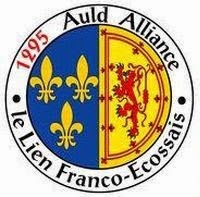
1295 Scotland and France formed the Auld Alliance against Edward I of England. The terms of the treaty stipulated that if either country was attacked by England, the other country would invade English territory.


649 Pope Martin I began his papacy.

1295 Scotland and France formed the Auld Alliance against Edward I of England. The terms of the treaty stipulated that if either country was attacked by England, the other country would invade English territory.

Published on July 05, 2014 04:57
July 4, 2014
Shelf Full of Books: Book Review: On Top of the Rainbow by K-Trina Mead...
Shelf Full of Books: Book Review: On Top of the Rainbow by K-Trina Mead...: On Top of the Rainbow By K-Trina Meador Publisher: K. Meador Published: Jan 6, 2014 ASIN: B00H4YYB6Y On Top of the Rainbow is c...
Friday, July 4, 2014
Book Review: On Top of the Rainbow by K-Trina Meador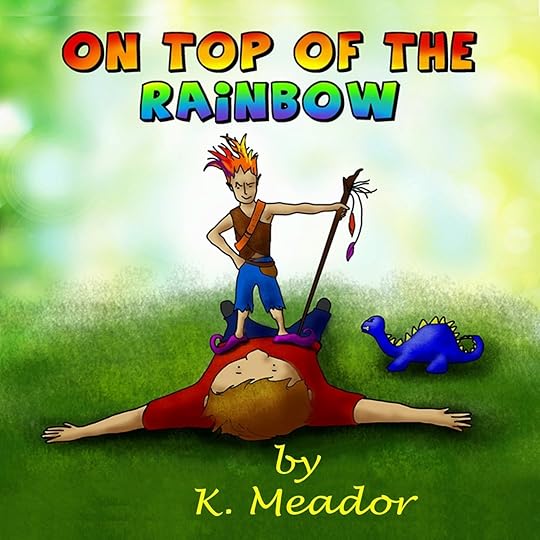 On Top of the RainbowBy K-Trina Meador My Thoughts:
On Top of the RainbowBy K-Trina Meador My Thoughts:
Five-year-old Gabe is given a toy airplane from his Papa that morning and accidentally breaks it. Upset about it, and afraid to tell his family that he broke it, he chooses to run away from home into the forest behind their home. There he meets a leprechaun and a unicorn and learns an important lesson or two.
I thought this was a lovely imaginary story with beautiful and quirky magical creatures. I liked that the leprechaun was different than how we typically picture them and that he did not immediately assume that Gabe was one of those boys that steal other people’s belongings. (Though I suppose one could assume that the way he asked the question could have sounded like he scared him into saying he wasn’t.)
The thought that family is the best thing above anything else on earth is a very important lesson. Whatever individual’s one’s family is comprised of, family is important, not the things that we own, for as Gabe discovered in his thinking about it, those things are gone in a flash. Family sticks around.
I liked too, that Gabe had to make a choice either to go forward to the other side of the rainbow and risk losing his family or to turn back and return to them as a sure thing. I think there is a lesson in that too. Whatever happens to us, we have made choices to get us where we are.
When Gabe is found by his family, they express the anxiety that any parent or guardian feels when their child disappears for even a short time. Hopefully that message also gets across to the child too of how much their family loves them and would be worried and fearful if he or she ever ran away.
The pictures were line drawings intermingled with vibrantly coloured drawings. They were very beautiful to look at.
I thought that At the Top of the Rainbow made good use of imaginary creatures in this story to teach the child aged 3 to 8 about how important family is and how running away doesn’t solve our problems. I gave this book 4 stars out of 5. I think it is a nice addition to any family library with young children.

Thank you to the author for providing a copy of this book in exchange for a fair and honest review. A positive opinion was not required. All thoughts are my own.
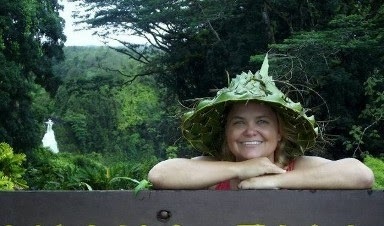 About the Author:
About the Author:
Born in Jacksonville, Florida and raised in Texas since she was four years old,K-Trina Meador is the youngest of five children. Growing up in Cross Plains, Texas, and being raised on a seventy acre farm gives her an appreciation for country life and the small town community. She has two grown sons.
She enjoys hiking, snorkeling, scuba diving, photography and aviation. She is currently traveling from state to state working as an aircraft mechanic and author. Current locations include: Hawaii, Georgia, South Carolina, and, currently, Oklahoma
Friday, July 4, 2014
Book Review: On Top of the Rainbow by K-Trina Meador
 On Top of the RainbowBy K-Trina Meador My Thoughts:
On Top of the RainbowBy K-Trina Meador My Thoughts:Five-year-old Gabe is given a toy airplane from his Papa that morning and accidentally breaks it. Upset about it, and afraid to tell his family that he broke it, he chooses to run away from home into the forest behind their home. There he meets a leprechaun and a unicorn and learns an important lesson or two.
I thought this was a lovely imaginary story with beautiful and quirky magical creatures. I liked that the leprechaun was different than how we typically picture them and that he did not immediately assume that Gabe was one of those boys that steal other people’s belongings. (Though I suppose one could assume that the way he asked the question could have sounded like he scared him into saying he wasn’t.)
The thought that family is the best thing above anything else on earth is a very important lesson. Whatever individual’s one’s family is comprised of, family is important, not the things that we own, for as Gabe discovered in his thinking about it, those things are gone in a flash. Family sticks around.
I liked too, that Gabe had to make a choice either to go forward to the other side of the rainbow and risk losing his family or to turn back and return to them as a sure thing. I think there is a lesson in that too. Whatever happens to us, we have made choices to get us where we are.
When Gabe is found by his family, they express the anxiety that any parent or guardian feels when their child disappears for even a short time. Hopefully that message also gets across to the child too of how much their family loves them and would be worried and fearful if he or she ever ran away.
The pictures were line drawings intermingled with vibrantly coloured drawings. They were very beautiful to look at.
I thought that At the Top of the Rainbow made good use of imaginary creatures in this story to teach the child aged 3 to 8 about how important family is and how running away doesn’t solve our problems. I gave this book 4 stars out of 5. I think it is a nice addition to any family library with young children.

Thank you to the author for providing a copy of this book in exchange for a fair and honest review. A positive opinion was not required. All thoughts are my own.
 About the Author:
About the Author:Born in Jacksonville, Florida and raised in Texas since she was four years old,K-Trina Meador is the youngest of five children. Growing up in Cross Plains, Texas, and being raised on a seventy acre farm gives her an appreciation for country life and the small town community. She has two grown sons.
She enjoys hiking, snorkeling, scuba diving, photography and aviation. She is currently traveling from state to state working as an aircraft mechanic and author. Current locations include: Hawaii, Georgia, South Carolina, and, currently, Oklahoma

Published on July 04, 2014 11:04
Diane Turner - London Rocks - 04.07.2014
Published on July 04, 2014 06:40
Happy Birthday USA
Published on July 04, 2014 05:32
History Trivia - Brightest known super-nova (Crab Nebula) shines, being visible for 23 days.
July 4
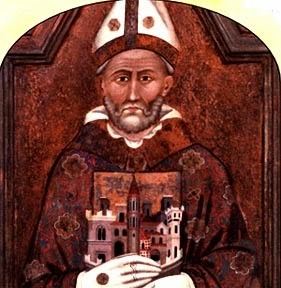
993 Saint Ulrich of Augsburg (leader of the Roman Catholic Church in Germany) was canonized. He studied at the monastery school of St. Gall and received additional training under Adalbero, Bishop of Augsburg, who made him a chamberlain. He was appointed Bishop of Augsburg by King Henry in 923.

1054 Brightest known super-nova (Crab Nebula) started shining, being visible for 23 days.
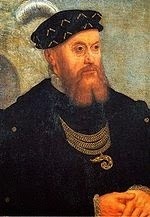
1534 Christian III was elected King of Denmark and Norway in the town of Rye.


993 Saint Ulrich of Augsburg (leader of the Roman Catholic Church in Germany) was canonized. He studied at the monastery school of St. Gall and received additional training under Adalbero, Bishop of Augsburg, who made him a chamberlain. He was appointed Bishop of Augsburg by King Henry in 923.

1054 Brightest known super-nova (Crab Nebula) started shining, being visible for 23 days.

1534 Christian III was elected King of Denmark and Norway in the town of Rye.

Published on July 04, 2014 05:31
July 3, 2014
First Birds Valued Fashion Over Flight
by Jennifer Viegas
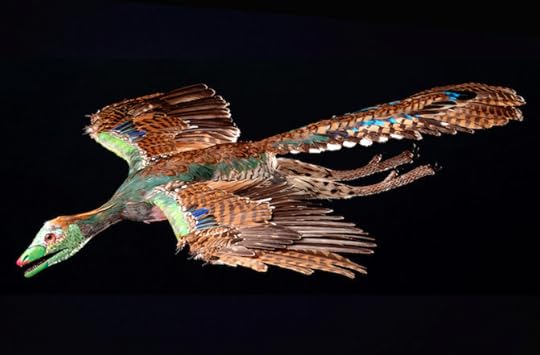 Recreation of ArchaeopteryxBayerische Staatssammlung für Paläontologie und Geologie Archaeopteryx, the iconic early bird that lived around 150 million years ago, sported feathered “trousers” on its hind limbs as well as other decorative feathers, and researchers now believe at least some non-avian dinosaur and bird feathers evolved for flashy display before they were later recruited for flight.
Recreation of ArchaeopteryxBayerische Staatssammlung für Paläontologie und Geologie Archaeopteryx, the iconic early bird that lived around 150 million years ago, sported feathered “trousers” on its hind limbs as well as other decorative feathers, and researchers now believe at least some non-avian dinosaur and bird feathers evolved for flashy display before they were later recruited for flight.
“The excellent preservation of the feathers in the new specimen helps to clarify many contentious issues,” senior author Oliver Rauhut of Ludwig-Maximilians University Munich told Discovery News. “The specimen not only shows the wing and tail feathers in great detail, but also body plumage and feathers along the hind limbs…(which are) similar to the feather ‘trousers’ found in many modern birds of prey.”The researchers determined that quill-like feathers covered Archaeopteryx’s entire body up to its head. Its hind limb feathers were symmetrical, indicating they didn't help with flight.
Its tail feathers were extremely long -- more than 60 percent of the length of its bony tail -- with some being asymmetrical and therefore useful in flight. Its wing feathers were also suitable for flight, and appear to have been just as strong as those seen in modern flying birds.
“There are a number of indications that Archaeopteryx was capable of aerial locomotion, but just how well it could fly remains debated,” Rauhut said, adding that the jury is still out as to whether Archaeopteryx was a non-avian dinosaur or a bird. That’s because the transition from one to the other happened gradually.
Current evidence does, however, suggest that Archaeopteryx was a representative of the main evolutionary lineage going toward birds. The evidence also suggests that Archaeopteryx and its dinosaur predecessors were colorful and flashy.
Rauhut shared that “it is very likely that dinosaurs could see colors, and many animals that have this capability tend to be colorful.” Prior studies support this theory.
He and his team suspect that, like modern birds, the colorful feathers likely were used in displays, such as for mating.
It appears that proto-feathers originally evolved for regulating body temperature. The quill-like contour feathers, on the other hand, could have first evolved for show.
“Once present, these feathers could then be adapted for many other functions, such as balance during fast running, protecting and shading the eggs during breeding, and flight,” Rauhut said.
“This is a fine and important piece of work on a great new specimen,” said Mark Norell, division chair and curator-in-charge of the American Museum of Natural History’s Division of Paleontology. “It clearly shows that the evolution of hind limb feathers is very complex and the evolution of feathers as a whole is de-coupled from flight.”
Lawrence Witmer, a professor of anatomy and paleontology at Ohio University, also believes that the new specimen “is a really important find.”
Witmer added, “When you combine the new information from Archaeopteryx with what we see in other bird-like dinosaurs and dinosaur-like birds, the picture that emerges is that maybe (quilled) feathers evolved more as ornaments for display and were later co-opted by evolution for flight … maybe multiple times. I think the authors make a good case. The display argument is very compelling.”
http://news.discovery.com/animals/dinosaurs/first-birds-valued-fashion-over-flight-140702.htm

 Recreation of ArchaeopteryxBayerische Staatssammlung für Paläontologie und Geologie Archaeopteryx, the iconic early bird that lived around 150 million years ago, sported feathered “trousers” on its hind limbs as well as other decorative feathers, and researchers now believe at least some non-avian dinosaur and bird feathers evolved for flashy display before they were later recruited for flight.
Recreation of ArchaeopteryxBayerische Staatssammlung für Paläontologie und Geologie Archaeopteryx, the iconic early bird that lived around 150 million years ago, sported feathered “trousers” on its hind limbs as well as other decorative feathers, and researchers now believe at least some non-avian dinosaur and bird feathers evolved for flashy display before they were later recruited for flight. “The excellent preservation of the feathers in the new specimen helps to clarify many contentious issues,” senior author Oliver Rauhut of Ludwig-Maximilians University Munich told Discovery News. “The specimen not only shows the wing and tail feathers in great detail, but also body plumage and feathers along the hind limbs…(which are) similar to the feather ‘trousers’ found in many modern birds of prey.”The researchers determined that quill-like feathers covered Archaeopteryx’s entire body up to its head. Its hind limb feathers were symmetrical, indicating they didn't help with flight.
Its tail feathers were extremely long -- more than 60 percent of the length of its bony tail -- with some being asymmetrical and therefore useful in flight. Its wing feathers were also suitable for flight, and appear to have been just as strong as those seen in modern flying birds.
“There are a number of indications that Archaeopteryx was capable of aerial locomotion, but just how well it could fly remains debated,” Rauhut said, adding that the jury is still out as to whether Archaeopteryx was a non-avian dinosaur or a bird. That’s because the transition from one to the other happened gradually.
Current evidence does, however, suggest that Archaeopteryx was a representative of the main evolutionary lineage going toward birds. The evidence also suggests that Archaeopteryx and its dinosaur predecessors were colorful and flashy.
Rauhut shared that “it is very likely that dinosaurs could see colors, and many animals that have this capability tend to be colorful.” Prior studies support this theory.
He and his team suspect that, like modern birds, the colorful feathers likely were used in displays, such as for mating.
It appears that proto-feathers originally evolved for regulating body temperature. The quill-like contour feathers, on the other hand, could have first evolved for show.
“Once present, these feathers could then be adapted for many other functions, such as balance during fast running, protecting and shading the eggs during breeding, and flight,” Rauhut said.
“This is a fine and important piece of work on a great new specimen,” said Mark Norell, division chair and curator-in-charge of the American Museum of Natural History’s Division of Paleontology. “It clearly shows that the evolution of hind limb feathers is very complex and the evolution of feathers as a whole is de-coupled from flight.”
Lawrence Witmer, a professor of anatomy and paleontology at Ohio University, also believes that the new specimen “is a really important find.”
Witmer added, “When you combine the new information from Archaeopteryx with what we see in other bird-like dinosaurs and dinosaur-like birds, the picture that emerges is that maybe (quilled) feathers evolved more as ornaments for display and were later co-opted by evolution for flight … maybe multiple times. I think the authors make a good case. The display argument is very compelling.”
http://news.discovery.com/animals/dinosaurs/first-birds-valued-fashion-over-flight-140702.htm

Published on July 03, 2014 12:29





